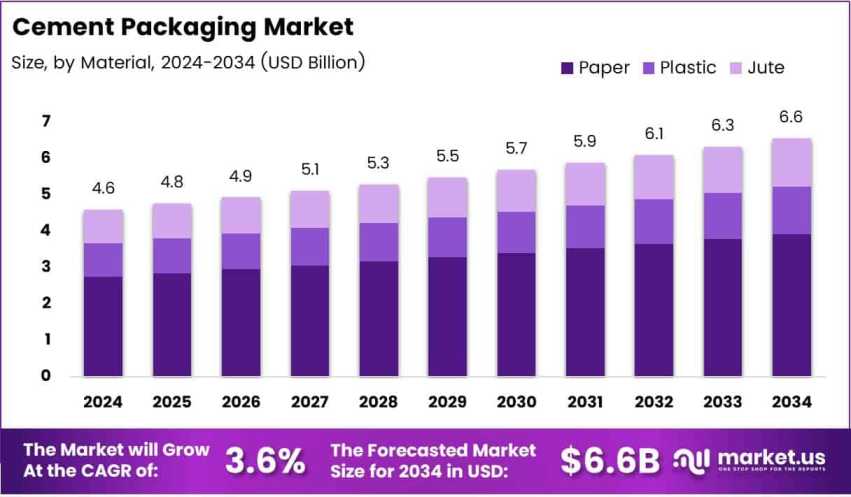Is Smart Cement Packaging the Future of Industrial Logistics?
1. Introduction
The Quiet Revolution in Cement Packaging
In an industry known for its bulk, weight, and dust, packaging has often been an afterthought. But a silent transformation is taking root. Cement packaging—long the domain of rugged paper sacks and plastic liners—is stepping into the digital age. With construction volumes soaring and supply chains under pressure, the humble cement bag is evolving into a node of intelligence, tracing, and efficiency.
Why Smart Logistics Begins with Smarter Bags
Industrial logistics is a symphony of timing, accuracy, and material flow. If the cement bag fails—rips, leaks, or misplaces—entire operations are disrupted. Enter smart cement packaging: an innovation where the container doesn’t just carry cement; it communicates, safeguards, and informs. The future of logistics, it seems, is printed, tagged, and encoded.
for more inform : https://market.us/report/cement-packaging-market/
2. The Rise of Smart Cement Packaging
Defining ‘Smart’ in the Context of Industrial Packaging
Smart packaging transcends the physical. It integrates technologies like sensors, barcodes, RFID, and IoT to collect and transmit data across the supply chain. In cement packaging, this intelligence offers end-to-end traceability, from plant to pallet to pouring site.
Digitalization of the Humble Cement Sack
No longer static, cement sacks are becoming responsive. Bags embedded with scannable tags can relay their origin, fill time, batch number, and current condition. With just a scan, logistics managers can assess delivery status or flag anomalies—no guesswork, no delays.
3. Technology Integration and Functional Benefits
RFID Tags, QR Codes, and Real-Time Tracking
Gone are the days of manually tallying cement sacks. Radio-frequency identification (RFID) tags now enable real-time location tracking, preventing losses and mix-ups across sprawling sites. QR codes on packaging add a layer of transparency, providing instant access to manufacturing data, safety protocols, or transport logs.
Moisture Sensors and Tamper-Evidence in Harsh Environments
Cement’s worst enemies are water and time. Smart packaging now includes moisture-sensitive labels that change color or trigger alerts when exposed to humidity. Some feature tamper-evident seals that register disturbances, alerting handlers of potential compromise. This isn’t just packaging; it’s protection with a brain.
4. Operational Efficiency and Cost Optimization
Streamlined Inventory Management and Supply Chain Visibility
Knowing exactly how much cement is where—down to the sack—enhances planning and procurement. Smart packaging feeds data directly into ERP systems, allowing auto-reordering, optimized routing, and predictive analytics. Overstocking, understocking, and ghost inventory become relics of the past.
Waste Reduction and Improved Material Handling
Smart packaging reduces mishandling and product damage. Automated alerts prevent storage in non-ideal conditions. Furthermore, optimized bag design and digital load tracking can reduce transportation costs and improve palletization. Less waste. Lower cost. Greater control.
5. Sustainability and Smart Packaging Convergence
Reducing Environmental Impact Through Data-Driven Efficiency
Cement manufacturing already faces pressure to decarbonize. Smart packaging complements this mission by reducing loss, ensuring fewer overproductions, and cutting unnecessary deliveries. With every data point collected, companies edge closer to zero-waste operations.
Adaptive Packaging for Climate-Specific Distribution
What works in Mumbai may fail in Munich. Smart cement packaging can adapt, using regional data to optimize materials—UV-resistant laminates for desert zones, hydrophobic coatings for monsoon regions. Packaging intelligence, when married with environmental awareness, creates a tailored solution.
for more inform : https://market.us/report/cement-packaging-market/
6. Challenges, Adoption Barriers, and the Road Ahead
Infrastructure, Cost, and Standardization Hurdles
Smart packaging isn’t without its friction. Infrastructure for scanning, tagging, and data management is still underdeveloped in many markets. Unit cost per smart bag remains higher than traditional options, though it’s narrowing. And there’s no universal protocol—each player runs on proprietary systems.
The Cement Sack of the Future: Predictive, Protective, and Planet-Friendly
Despite hurdles, the trajectory is clear. Tomorrow’s cement packaging will be an active participant in logistics. It will warn of moisture, flag delays, integrate with AI-based systems, and biodegrade when its job is done. It won’t just hold cement—it will hold answers.
7. Future Outlook
Digital Integration and AI in Cement Packaging
The future of cement packaging lies at the intersection of material science and artificial intelligence. AI algorithms are being developed to monitor packaging defects in real time, optimize material usage, and reduce waste. Predictive analytics will soon allow companies to anticipate supply chain disruptions before they occur, ensuring uninterrupted packaging operations.
Forecasting the Market Beyond 2030
By 2030, the cement packaging market is expected to be not just bigger — but smarter, greener, and more resilient. Modular packaging systems, responsive to different climatic and logistic conditions, will become the norm. With urban growth continuing unabated and sustainability anchoring every business decision, the humble cement sack is poised to undergo a metamorphosis — from utility to ingenuity.
7. Future Outlook
Digital Integration and AI in Cement Packaging
The future of cement packaging lies at the intersection of material science and artificial intelligence. AI algorithms are being developed to monitor packaging defects in real time, optimize material usage, and reduce waste. Predictive analytics will soon allow companies to anticipate supply chain disruptions before they occur, ensuring uninterrupted packaging operations.
Forecasting the Market Beyond 2030
By 2030, the cement packaging market is expected to be not just bigger — but smarter, greener, and more resilient. Modular packaging systems, responsive to different climatic and logistic conditions, will become the norm. With urban growth continuing unabated and sustainability anchoring every business decision, the humble cement sack is poised to undergo a metamorphosis — from utility to ingenuity.
- Valve vs. Open Mouth: Which Cement Bag Wins in 2025?
- Explore the evolving Cement Packaging Market, driven by innovation, sustainability, and rising global construction demand. Discover trends in materials, automation, and eco-friendly solutions reshaping the industry, from kraft paper to smart sacks, across Asia, Europe, and North America.
- Cement Packaging Construction Packaging Sustainable Packaging
Related posts:
 Easy EMI Card: Your Go-To Solution for Easy Monthly Payments
Easy EMI Card: Your Go-To Solution for Easy Monthly Payments
 Fitness for Mental Clarity: Unlock Your Focus and Inner Strength with DG FIT MIND
Fitness for Mental Clarity: Unlock Your Focus and Inner Strength with DG FIT MIND
 Top Carrier Oil Suppliers in India for Bulk & Wholesale Buyers
Top Carrier Oil Suppliers in India for Bulk & Wholesale Buyers
 Atlas Pro ONTV : La Révolution de la Télévision par Internet
Atlas Pro ONTV : La Révolution de la Télévision par Internet
 Essentials Hoodie Design Philosophy: Minimalism Meets Statement
Essentials Hoodie Design Philosophy: Minimalism Meets Statement
 Integrating Type form with High Level: A Comprehensive Guide
Integrating Type form with High Level: A Comprehensive Guide
 What Solar Looks Like on Flat Roofs, Metal Roofs, and Shingles?
What Solar Looks Like on Flat Roofs, Metal Roofs, and Shingles?
 When Best Stock Market Institute Delhi Becomes Your Turning Point Forever
When Best Stock Market Institute Delhi Becomes Your Turning Point Forever






